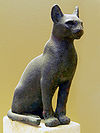Bastet
| Bastet in hieroglyphics | ||||||
|---|---|---|---|---|---|---|
| here |
Bastet B3stt |
|||||
| or with determinative |
|
|||||
| Bastet with Ankh | ||||||
| Bastet ( Senckenberg Natural History Museum ) | ||||||
Bastet is the daughter of the sun god Re, portrayed in Egyptian mythology as the cat goddess .
presentation
Bastet was represented as a lioness in the Old Kingdom (in the pyramid texts ), which makes it easy to confuse her with Menhit , Sachmet or Thermutis . She was later portrayed as a sitting cat .
meaning
She was worshiped by the Egyptians as the goddess of fertility, often depicted as a cat or woman with a cat or a lion head. As the goddess of fertility and love, Bastet also acts as a protector of pregnant women. She is also the goddess of joy, dance, music and celebrations. Originally, she had both angry and gentle qualities. In the course of time the angry being was given to the goddess Sekhmet , who becomes the shadow, the destructive side of Bastet.
In Bubastis Bastet was considered the mother of the lion god Mahes and in Heliopolis she was worshiped as the daughter of Atum , according to other traditions she is considered the daughter of Nefertem . She is also mentioned as the mother of Anubis .
Bastet was equated with the goddess Hathor in the Old Kingdom and at that time in Memphis with the goddess Sachmet. In the Middle Kingdom , it was equated with the goddess Mut .
Cult and cult places
Bastet was worshiped in Bubastis and Memphis in the Old Kingdom and the cult later spread across Egypt. The worship of the goddess eventually reached a late peak during the Greco-Roman period in ancient Egypt. The sacrifice of cats mummified for this purpose is known as a cult. The Bastet priests raised cats and offered them to the population for sacrificial purposes. If a believer bought a cat of his choice, it was killed by a priest. The priest then subjected the dead cat to the same traditional process of mummification that was common with humans. Depending on how much the buyer paid, the priests gave him either a large mummy or a small one. The buyer then placed the mummy in a burial chamber specially used for the purpose of cat sacrifices. If the believer wanted to please the goddess Bastet in particular, he bought several cats at once. However, x-rays of hundreds of cat mummies found in burial chambers in the Valley of the Kings have shown that in about a quarter of the cases the mummy was either completely empty or contained only individual cat bones. Whether the priests have deliberately cheated or whether it was only a temporary shortage of cats can no longer be determined today.
“When a cat dies in a house, everyone in the house shaves off their eyebrows [...]. The dead cats are brought to the city of Bubastis, embalmed and buried in sacred burial chambers. "
The killing of a cat outside the sacred precinct was a capital felony worthy of death that was severely prosecuted.
The Bastet Festival (also called Nice Festival of Drunkenness): The festival of drunkenness, marked by intoxication, music and debauchery, was celebrated annually for Bastet ("Bubasteia"), which is attested for Bubastis in other places in the country. A brief description of the orgiastic activity during this festival can be found in Herodotus (II 60). His characterization of the event is underpinned by Egyptian sources, such as a cheerful, crude demotic poetry from the 2nd century AD, the pornographic content of which is evidently related to a festival in honor of Bastet and drunkenness.
Bastet with similarities as a sachmet
Mummy mask of a cat (Oriental Institute Museum at the University of Chicago )
Two cat mummies ( Royal Ontario Museum )
Bronze statue from the Louvre (Paris)
See also
literature
- Kurt Sethe : Bubastis 1 . In: Paulys Realencyclopadie der classischen Antiquity Science (RE). Volume III, 1, Stuttgart 1897, Col. 930 f.
- Veronica Ions: The gods and myths of Egypt (= the great religions of the world - gods, myths and legends ). Neuer Kaiser Verlag - Book and World, Klagenfurt 1988.
- Hans Bonnet : Lexicon of the Egyptian religious history. 3rd edition, Nikol, Hamburg 2000, ISBN 3-937872-08-6 , pp. 80-82.
Web links
- Holger Kockelmann: Bastet. In: Michaela Bauks, Klaus Koenen, Stefan Alkier (eds.): The scientific biblical lexicon on the Internet (WiBiLex), Stuttgart 2006 ff., Accessed on May 26, 2012.
Individual evidence
- ↑ Rolf Felde: Egyptian gods. 2nd expanded and improved edition, self-published, Wiesbaden 1995, p. 11.
- ↑ Hans Wilhelm Haussig (Ed.): Historien / Herodot. Translated by A. Horneffer . (= Kröner's pocket edition. Volume 224). German complete edition, 4th edition, Kröner, Stuttgart 1971, ISBN 3-520-22404-6 , p. 129.






